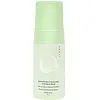What's inside
What's inside
 Key Ingredients
Key Ingredients

No key ingredients
 Benefits
Benefits

 Concerns
Concerns

No concerns
 Ingredients Side-by-side
Ingredients Side-by-side

Water
Skin ConditioningCasein Extract
Skin ConditioningCucumis Sativus Fruit Extract
EmollientCoco-Glucoside
CleansingSodium Lauryl Glucose Carboxylate
CleansingLauryl Glucoside
CleansingCocamidopropyl Betaine
CleansingAcrylates Copolymer
Glycerin
HumectantMicrocrystalline Cellulose
AbsorbentCellulose Gum
Emulsion StabilisingXylitylglucoside
HumectantAnhydroxylitol
HumectantXylitol
HumectantSaccharide Hydrolysate
HumectantPhenoxyethanol
PreservativeEthylhexylglycerin
Skin ConditioningRapeseed Sophorolipids
AntimicrobialSodium Gluconate
Skin ConditioningTriethanolamine
BufferingDisodium EDTA
Water, Casein Extract, Cucumis Sativus Fruit Extract, Coco-Glucoside, Sodium Lauryl Glucose Carboxylate, Lauryl Glucoside, Cocamidopropyl Betaine, Acrylates Copolymer, Glycerin, Microcrystalline Cellulose, Cellulose Gum, Xylitylglucoside, Anhydroxylitol, Xylitol, Saccharide Hydrolysate, Phenoxyethanol, Ethylhexylglycerin, Rapeseed Sophorolipids, Sodium Gluconate, Triethanolamine, Disodium EDTA
Water
Skin ConditioningGlycerin
HumectantDisodium Cocoyl Glutamate
CleansingDisodium Cocoamphodiacetate
CleansingPropanediol
SolventSodium PCA
HumectantMaltooligosyl Glucoside
Skin ConditioningHydrogenated Starch Hydrolysate
HumectantNiacinamide
SmoothingInulin
Skin ConditioningGluconolactone
Skin ConditioningSodium Benzoate
MaskingTrehalose
HumectantPanthenol
Skin ConditioningBifida Ferment Lysate
Skin ConditioningSodium Gluconate
Skin ConditioningAllantoin
Skin ConditioningSodium Hyaluronate
HumectantEuterpe Oleracea Fruit Extract
Citric Acid
BufferingWater, Glycerin, Disodium Cocoyl Glutamate, Disodium Cocoamphodiacetate, Propanediol, Sodium PCA, Maltooligosyl Glucoside, Hydrogenated Starch Hydrolysate, Niacinamide, Inulin, Gluconolactone, Sodium Benzoate, Trehalose, Panthenol, Bifida Ferment Lysate, Sodium Gluconate, Allantoin, Sodium Hyaluronate, Euterpe Oleracea Fruit Extract, Citric Acid
 Reviews
Reviews

Ingredients Explained
These ingredients are found in both products.
Ingredients higher up in an ingredient list are typically present in a larger amount.
Glycerin is already naturally found in your skin. It helps moisturize and protect your skin.
A study from 2016 found glycerin to be more effective as a humectant than AHAs and hyaluronic acid.
As a humectant, it helps the skin stay hydrated by pulling moisture to your skin. The low molecular weight of glycerin allows it to pull moisture into the deeper layers of your skin.
Hydrated skin improves your skin barrier; Your skin barrier helps protect against irritants and bacteria.
Glycerin has also been found to have antimicrobial and antiviral properties. Due to these properties, glycerin is often used in wound and burn treatments.
In cosmetics, glycerin is usually derived from plants such as soybean or palm. However, it can also be sourced from animals, such as tallow or animal fat.
This ingredient is organic, colorless, odorless, and non-toxic.
Glycerin is the name for this ingredient in American English. British English uses Glycerol/Glycerine.
Learn more about GlycerinThis is the synthetic salt of gluconic acid, a form of PHA and mild exfoliant.
It is mainly used to stabilize oil and butter formulations from going bad. Sodium gluconate is a humectant, pH regulator, and chelating agent.
Chelating agents help neutralize unwanted metals from affecting the formulation.
Sodium gluconate is water-soluble.
Learn more about Sodium GluconateWater. It's the most common cosmetic ingredient of all. You'll usually see it at the top of ingredient lists, meaning that it makes up the largest part of the product.
So why is it so popular? Water most often acts as a solvent - this means that it helps dissolve other ingredients into the formulation.
You'll also recognize water as that liquid we all need to stay alive. If you see this, drink a glass of water. Stay hydrated!
Learn more about Water